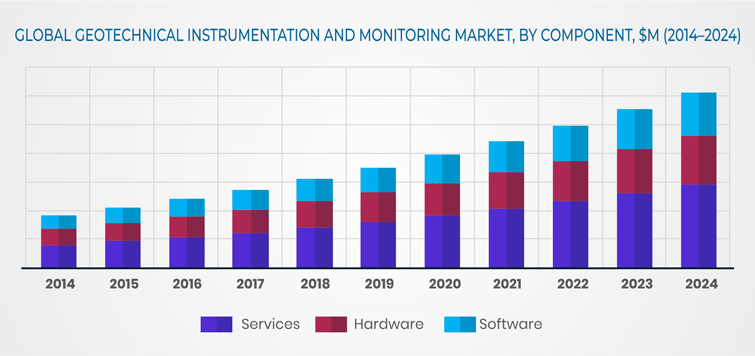Increasing Construction of Skyscrapers Propelling Geotechnical Instrumentation and Monitoring Market Expansion
From $3.1 billion in 2018, the geotechnical instrumentation and monitoring market is predicted to reach a revenue of $6.1 billion by 2024. According to the forecast of the market research organization, P&S Intelligence, the market will progress at a CAGR of 11.8% from 2019 to 2024. The market is being driven by the booming construction sector all over the world. Additionally, the increasing focus of the governments of several countries on developing sustainable infrastructure and rapid urbanization are also driving the growth of the market.
With rapid urbanization, the number of infrastructural development projects is rising. Moreover, many countries are making huge investments in these projects in order to cater to the needs of a booming population. For instance, an overall investment of $11 trillion was made in the global construction industry in 2017, and this is predicted to rise to $13.5 trillion by the end of 2024. The expansion of the construction industry is being propelled by the surging number of infrastructural development projects in countries, such as the U.S., India, and China.
Besides, the construction of skyscrapers in several countries, on account of the growing migration of people from rural areas to cities and rapid urbanization, is also fueling the growth of the geotechnical instrumentation and monitoring market. This is because geotechnical instruments are needed in the planning phase of skyscrapers in order to determine the specifics regarding the foundation of these structures. According to various reports, around 55% of the global population resided in urban areas in 2018, and this share is predicted to rise to 68% by 2030.
Depending on component, the market is divided into services, software, and hardware. Out of these, the services category held the largest share in the market in the past, and it is predicted to contribute the highest revenue to the market in the upcoming years as well. This is credited to the burgeoning requirement for these services for continuously monitoring critical structures in the energy and power sector. Additionally, the rising focus on monitoring old and critical structures, such as dams, because of the implementation of strict safety regulations by several governments, is also positively impacting the growth of the industry.
Across the world, the Asia-Pacific (APAC) region is predicted to be the fastest-growing region in the geotechnical instrumentation and monitoring market in the coming years. This is attributed to the surging number of infrastructural development projects in regional countries, such as India and China. Moreover, China is making huge investments for countering the effects of the economic slowdown. For instance, the Chinese government has given approval to 27 projects and invested $219.4 billion in these projects since 2018.
Therefore, it is safe to say that the demand for geotechnical instrumentation and monitoring services will surge in the coming years, primarily because of the increasing number of construction and infrastructural development projects in various countries around the world.
Read More: https://www.psmarketresearch.com/market-analysis/geotechnical-instrumentation-and-monitoring-market
From $3.1 billion in 2018, the geotechnical instrumentation and monitoring market is predicted to reach a revenue of $6.1 billion by 2024. According to the forecast of the market research organization, P&S Intelligence, the market will progress at a CAGR of 11.8% from 2019 to 2024. The market is being driven by the booming construction sector all over the world. Additionally, the increasing focus of the governments of several countries on developing sustainable infrastructure and rapid urbanization are also driving the growth of the market.
With rapid urbanization, the number of infrastructural development projects is rising. Moreover, many countries are making huge investments in these projects in order to cater to the needs of a booming population. For instance, an overall investment of $11 trillion was made in the global construction industry in 2017, and this is predicted to rise to $13.5 trillion by the end of 2024. The expansion of the construction industry is being propelled by the surging number of infrastructural development projects in countries, such as the U.S., India, and China.
Besides, the construction of skyscrapers in several countries, on account of the growing migration of people from rural areas to cities and rapid urbanization, is also fueling the growth of the geotechnical instrumentation and monitoring market. This is because geotechnical instruments are needed in the planning phase of skyscrapers in order to determine the specifics regarding the foundation of these structures. According to various reports, around 55% of the global population resided in urban areas in 2018, and this share is predicted to rise to 68% by 2030.
Depending on component, the market is divided into services, software, and hardware. Out of these, the services category held the largest share in the market in the past, and it is predicted to contribute the highest revenue to the market in the upcoming years as well. This is credited to the burgeoning requirement for these services for continuously monitoring critical structures in the energy and power sector. Additionally, the rising focus on monitoring old and critical structures, such as dams, because of the implementation of strict safety regulations by several governments, is also positively impacting the growth of the industry.
Across the world, the Asia-Pacific (APAC) region is predicted to be the fastest-growing region in the geotechnical instrumentation and monitoring market in the coming years. This is attributed to the surging number of infrastructural development projects in regional countries, such as India and China. Moreover, China is making huge investments for countering the effects of the economic slowdown. For instance, the Chinese government has given approval to 27 projects and invested $219.4 billion in these projects since 2018.
Therefore, it is safe to say that the demand for geotechnical instrumentation and monitoring services will surge in the coming years, primarily because of the increasing number of construction and infrastructural development projects in various countries around the world.
Read More: https://www.psmarketresearch.com/market-analysis/geotechnical-instrumentation-and-monitoring-market
Increasing Construction of Skyscrapers Propelling Geotechnical Instrumentation and Monitoring Market Expansion
From $3.1 billion in 2018, the geotechnical instrumentation and monitoring market is predicted to reach a revenue of $6.1 billion by 2024. According to the forecast of the market research organization, P&S Intelligence, the market will progress at a CAGR of 11.8% from 2019 to 2024. The market is being driven by the booming construction sector all over the world. Additionally, the increasing focus of the governments of several countries on developing sustainable infrastructure and rapid urbanization are also driving the growth of the market.
With rapid urbanization, the number of infrastructural development projects is rising. Moreover, many countries are making huge investments in these projects in order to cater to the needs of a booming population. For instance, an overall investment of $11 trillion was made in the global construction industry in 2017, and this is predicted to rise to $13.5 trillion by the end of 2024. The expansion of the construction industry is being propelled by the surging number of infrastructural development projects in countries, such as the U.S., India, and China.
Besides, the construction of skyscrapers in several countries, on account of the growing migration of people from rural areas to cities and rapid urbanization, is also fueling the growth of the geotechnical instrumentation and monitoring market. This is because geotechnical instruments are needed in the planning phase of skyscrapers in order to determine the specifics regarding the foundation of these structures. According to various reports, around 55% of the global population resided in urban areas in 2018, and this share is predicted to rise to 68% by 2030.
Depending on component, the market is divided into services, software, and hardware. Out of these, the services category held the largest share in the market in the past, and it is predicted to contribute the highest revenue to the market in the upcoming years as well. This is credited to the burgeoning requirement for these services for continuously monitoring critical structures in the energy and power sector. Additionally, the rising focus on monitoring old and critical structures, such as dams, because of the implementation of strict safety regulations by several governments, is also positively impacting the growth of the industry.
Across the world, the Asia-Pacific (APAC) region is predicted to be the fastest-growing region in the geotechnical instrumentation and monitoring market in the coming years. This is attributed to the surging number of infrastructural development projects in regional countries, such as India and China. Moreover, China is making huge investments for countering the effects of the economic slowdown. For instance, the Chinese government has given approval to 27 projects and invested $219.4 billion in these projects since 2018.
Therefore, it is safe to say that the demand for geotechnical instrumentation and monitoring services will surge in the coming years, primarily because of the increasing number of construction and infrastructural development projects in various countries around the world.
Read More: https://www.psmarketresearch.com/market-analysis/geotechnical-instrumentation-and-monitoring-market
·5K vues
·0 Avis






